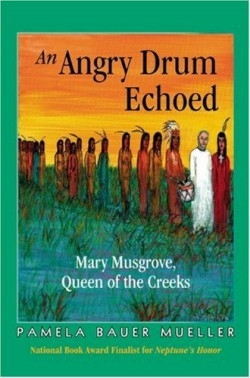An Angry Drum Echoed
- 2007 INDIES Finalist
- Finalist, Historical (Adult Fiction)
“Dear Mary, only you can guarantee the complete loyalty of the Yamacraws and the other Creeks,” pleaded General James Ogelthorpe in 1736, just three years after establishing the colony of Georgia with Mary Musgrove’s help. Born around 1700 to a Creek mother and an English father, Mary learned the language, religion, and culture of both of her parents, enabling her to diplomatically serve as interpreter and representative of both Creek and English interests. In the prologue to this fictionalized account of her life, Mary ponders her lifelong commitment to helping foster Indian and English camaraderie. “As a daughter of both the Creek and English nations, I was able to keep the peace between them.”
When Mary married Englishman John Musgrove, the governor asked the couple to establish a trading post and encourage Indians to move near it. They were so successful, he later told them about a group of colonists due to arrive in 1732; he hoped they would “assist the English and smooth the way with the resident Indians.” Despite Mary’s hard work, English trustees refused to fully compensate her or recognize her right to land she acquired. Followed by an army of Native Americans beating angrily on drums, Mary demanded land from English officials.
Though the first person narrative does much to transport the reader to Mary’s time and location, a shift to third person in a few of the chapters renders the story remote. The author, who graduated from Lewis and Clark College with a bachelor’s in Spanish, began her writing career with the Kiska Trilogy, The Bumpedy Road, Rain City Cats, and Eight Paws to Georgia. She has carefully researched the details included in An Angry Drum Echoed in the manner she used when writing Neptune’s Honor, for which she was named the 2006 winner of the Georgia Author of the Year Award.
The historical details offered provide information most history textbooks are not equipped to include because of their broad focus. Illustrations of General Ogelthorpe, Chief Tomochichi and his nephew are followed by a map of St. Simons Island in 1742 and plans for the development of Savannah, Georgia. While a timeline chronicling Mary’s life would have been a great addition, the author does provide a useful list of sources and a glossary of terms.
The book’s four sections are named after the four seasons that were symbolic of Mary’s growth and maturity (i.e., the winter focuses on the last years of Mary’s life). Mary Musgrove died in 1765. This book will commemorate her commitment to Indian and English interests.
Disclosure: This article is not an endorsement, but a review. The publisher of this book provided free copies of the book to have their book reviewed by a professional reviewer. No fee was paid by the publisher for this review. Foreword Reviews only recommends books that we love. Foreword Magazine, Inc. is disclosing this in accordance with the Federal Trade Commission’s 16 CFR, Part 255.

